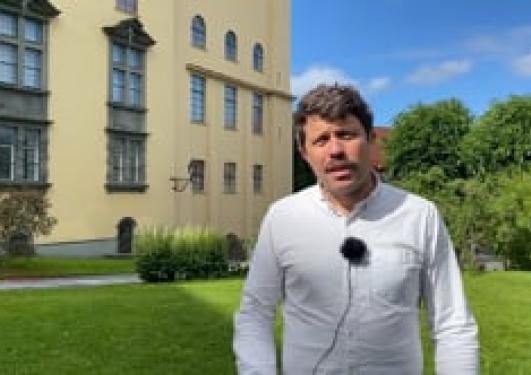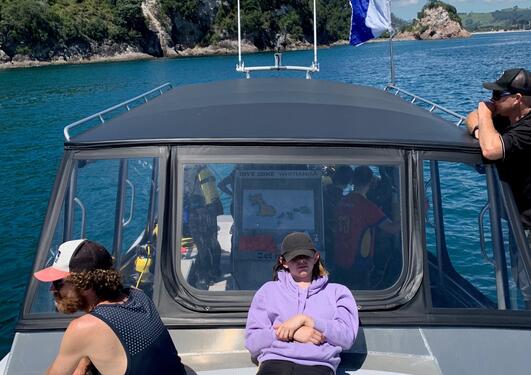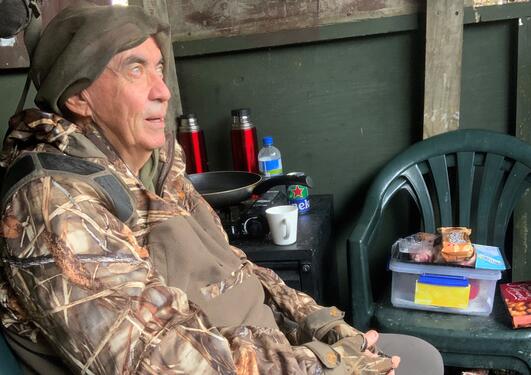Seasonal carving - a workshop with Year 13 high school children
How can enthusiasm and engagement be fostered in high school children?

Main content
Perhaps surprisingly, the answer can be simple: They need to be given the opportunity to connect with their natural surrounding and the outdoors. In times of ubiquitous electronic distractions and urbanization, children can feel more at home in shopping malls than in the outdoors. And so, taking them out to feel the seasons and participate in activities where they experience the elements can have a range of benefits. The connection with nature may even represent a missing link that triggers reflections and activities that would otherwise not occur.
The aim of the Outdoor Education Class is to expose students to a range of challenging outdoor activities in order to build confidence, self-reliance and an appreciation of nature. The connection with the CALENDARS project enabled students to think deeper about what activities were chosen at different stages of the year. It would be rare, if not impossible for students to be exposed to the changing nature of the environment in a traditional classroom with its barriers to the outside world.
It was at a winter ‘survival’ camp in dense Coromandel bush, when we were all huddled around the fire trying to stay warm, when about half the students were using their pocketknives to shape bits of wood that they had found. They were not carving anything in particular. It appeared to be more an innate desire to be creative. To craft something by hand. Something humans would have done since … forever really. It felt good, it felt like it “belonged” there and then. A warming fire, hot drinks, being creative and sharing stories. The act of carving helped put students at ease, busy hands enabled minds to drift and stories to surface.
It was that evening that the seed was planted for what would turn into a three-day wood carving workshop in the first week of November 2021, involving renowned local Maori carver Darin Jenkins and distinguished local artist Fatu Feu’u, a master carver in his own right. The plan was to encourage the children to carve their own seasonal representations. ‘What markers are there in their lives’? and ‘How can these be symbolized?’ were among the key questions.
The children were excited by this plan and so were we. This was an opportunity to do something that had not been done before in this way. We began by inviting the children to first think of symbols that they would use as seasonal representations. This is an old idea in maori culture, where tohunga (a person with knowledge/skills) would look for tohu (signs) of the changing seasons, such as the arrival of the godwit as a marker of spring. Some of important symbols for the students were water, sunshine, clothing, food, activity, and sleep/wake rhythms to name but a few. These are all subject to seasonal fluctuations, yet it is something that children are rarely encouraged to reflect on. Here was the opportunity to delve deeper into what the seasons mean for high school children about to be released into adult life. The layers of discussions were backed up by seasonal activities ranging from snorkeling in summer, raft building as the water temperatures dropped, fire lighting as the soil became damp as the days shortened, feasting at the beginning of winter, an overnight survival camp to celebrate matariki, a period of introspection and creativity as the cold deepened – including time spent forging steel blades. Students’ relationship with the water was most apparent with them highlighting the joys of full immersion swimming in the summertime, being on but not in the water in autumn e.g., sea kayaking, avoiding the water in the winter and then tentative dips and quick dunk challenges in the spring. Growing up in the Coromandel, the students may not recognize the significance of this relationship, but as one past Thames High School student commented after spending time away: “It’s not a real summer without a swim in the Kauaeranga River”.
An aspect that was missing from the discussions about symbols was celebrations or events – Easter, Halloween, Christmas, summer/winter solstice, etc. These did not factor into the students’ carving and this may indicate the disassociation between what students see in Northern Hemisphere culture, e.g., snowy Christmas, abundance and growth of springtime Easter, death and remembrance of the autumnal Halloween and what happens in their environment during those times. For example, one student carved a cricket bat as his symbol of summer, which wouldn’t be a popular activity in the Northern Hemisphere at that time.
While the seasons were experienced by all children, it was interesting to hear that the seasonal experience differed. For example, one student declared summer as his least favorite time because of the heat. Instead, he looks forward to the beginning of winter when the football season commences. The cold days are ideal for him to train hard. Another student shares this experience: Her role as rugby manager has become a significant marker of her seasonal rhythms over the five winters that she has found herself in this position. Summer, however, has a different meaning for her: Every year, she and her family leave behind technology and go camping. Her highlight has become to come together in the evenings around a fire and share stories, similar to the winter ‘survival’ camp. It’s all about coming together. For one student who experiences great joy during the hunting season and particularly the ‘roar’, this is the time of the year that follows a family tradition where he gets to spend quality time with his father
And the symbols chosen to represent seasons? One symbol that was carved by many was that of fire. Interestingly, for some this represented the colder months and for other it was a summer ‘thing’. Other symbols included references to hunting, the moon phases, flowering Pohutukawa, fish, surf boards, sunshine, camping, sports equipment. The one thing that all the children’s wooden calendars had in common was that, for them, the year begins in summer and ends in summer. After all, that is culturally how they have learned to understand the Calendar. Would the same workhop in the northern hemisphere have resulted in the year starting in winter and ending in winter? Another common element was that all students carved their piece of wood horizontally from left to right instead of experimenting with other directions such as vertically (down/up) or circular.
The conclusion from the carving workshop is that this was a highly rewarding exercise that provided insight into the individual and collective seasonal representations of high school children. They provided a refreshing new way of thinking about seasonality that revolves around markers that are not economically driven. Moreover, thanks to Fatu and Darin, the workshop gave the children an impetus to think creatively about symbols and the simplification of seasonal markers. This also meant that the children had to think about how ‘their’ year is structured and what the different seasons mean to them. An interesting insight was that the students demonstrated a strong connection with their natural world and that external influences, such as the internet and social media, did not feature at all in a seasonal context.
And finally, the workshop introduced the children to carving – an activity that they already took up without realizing as they were sitting around the winter campfire and telling stories.




